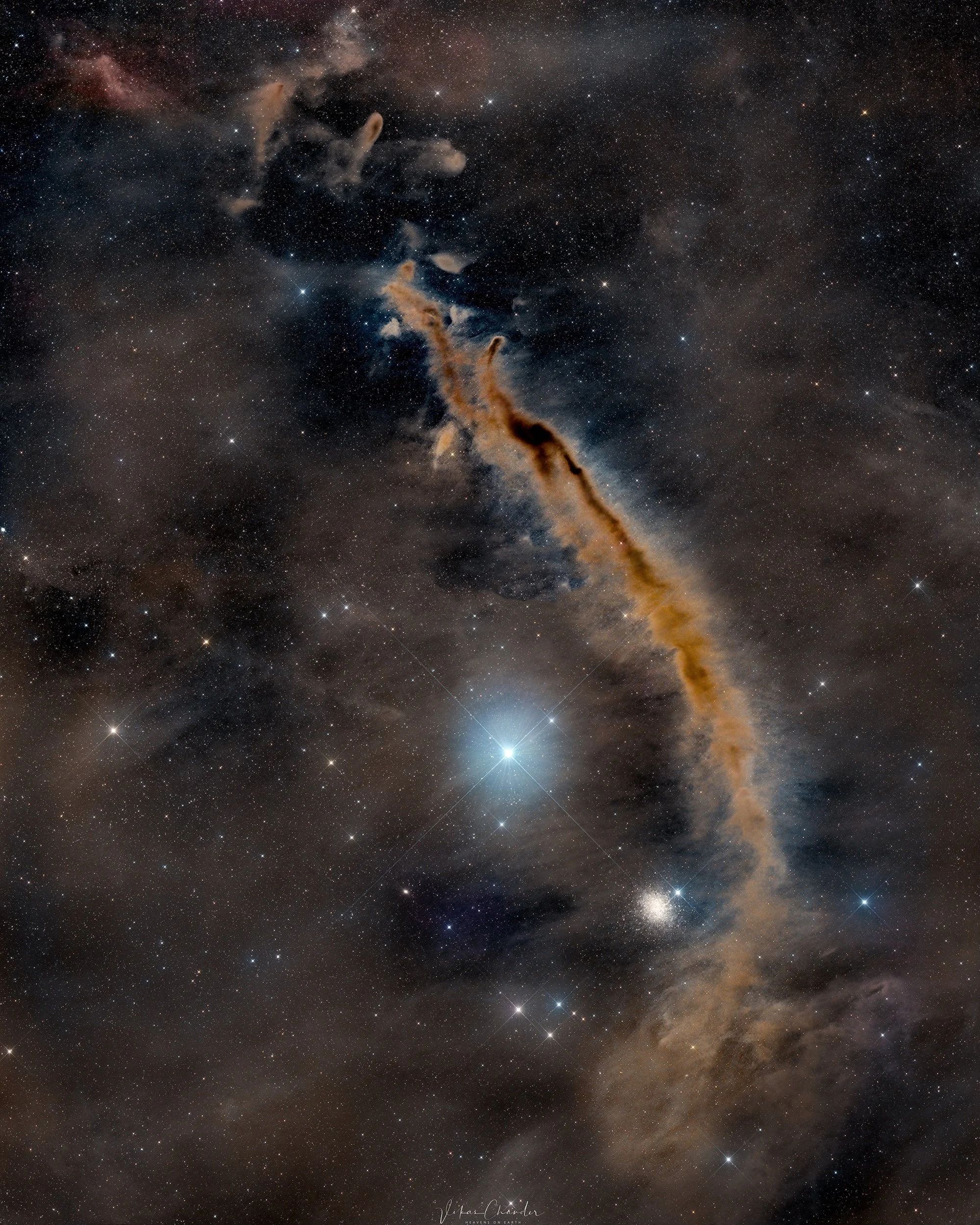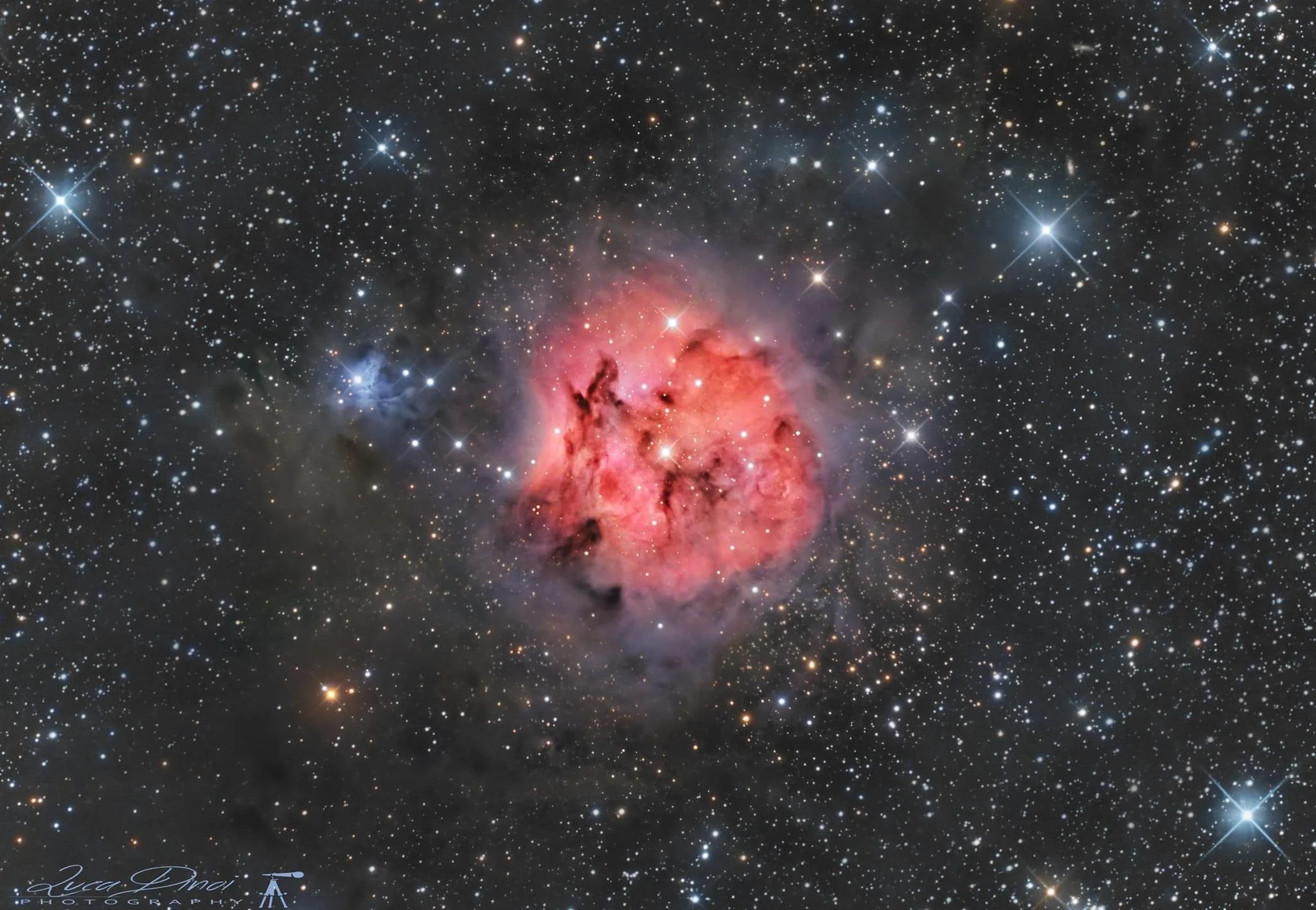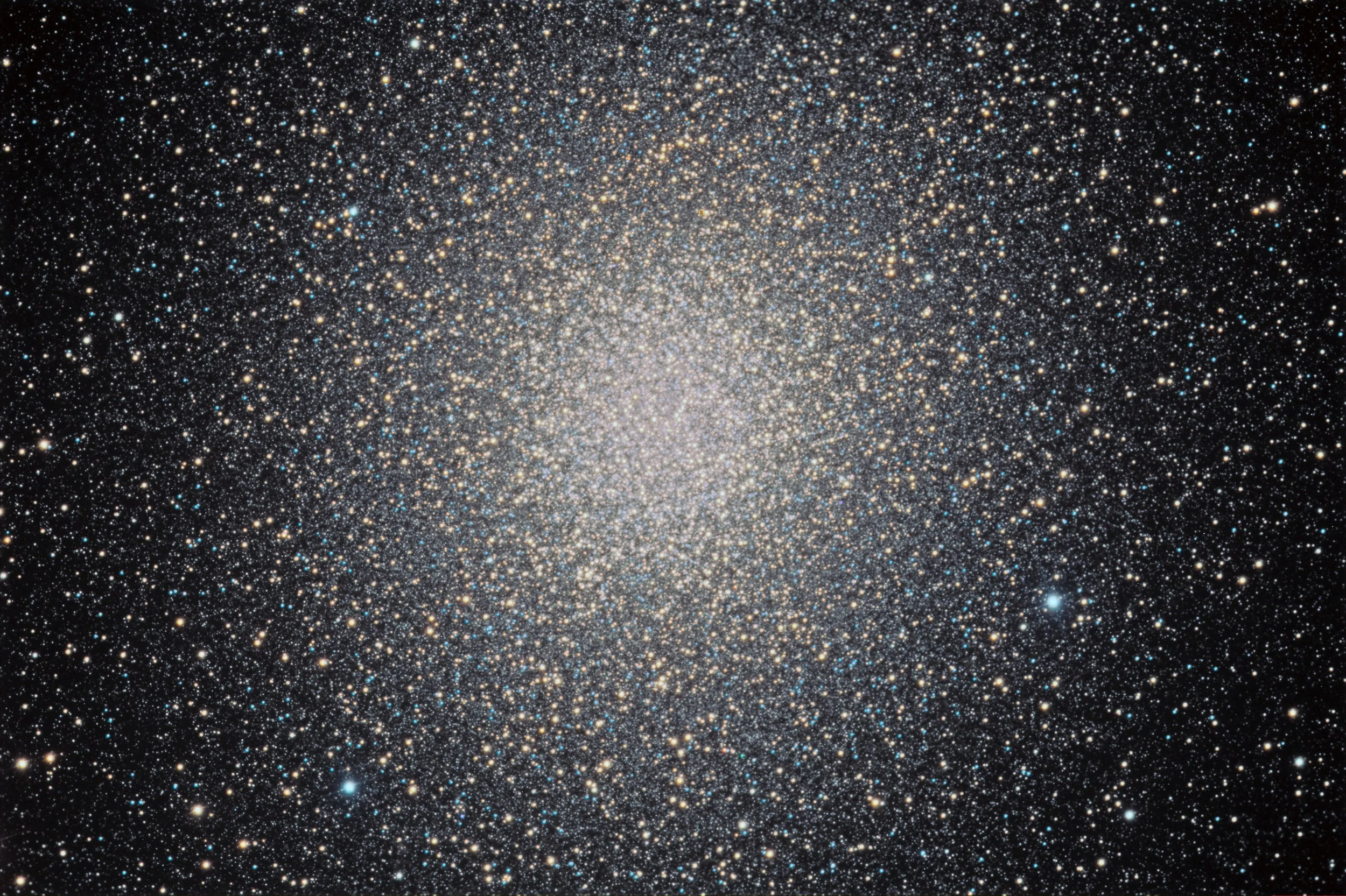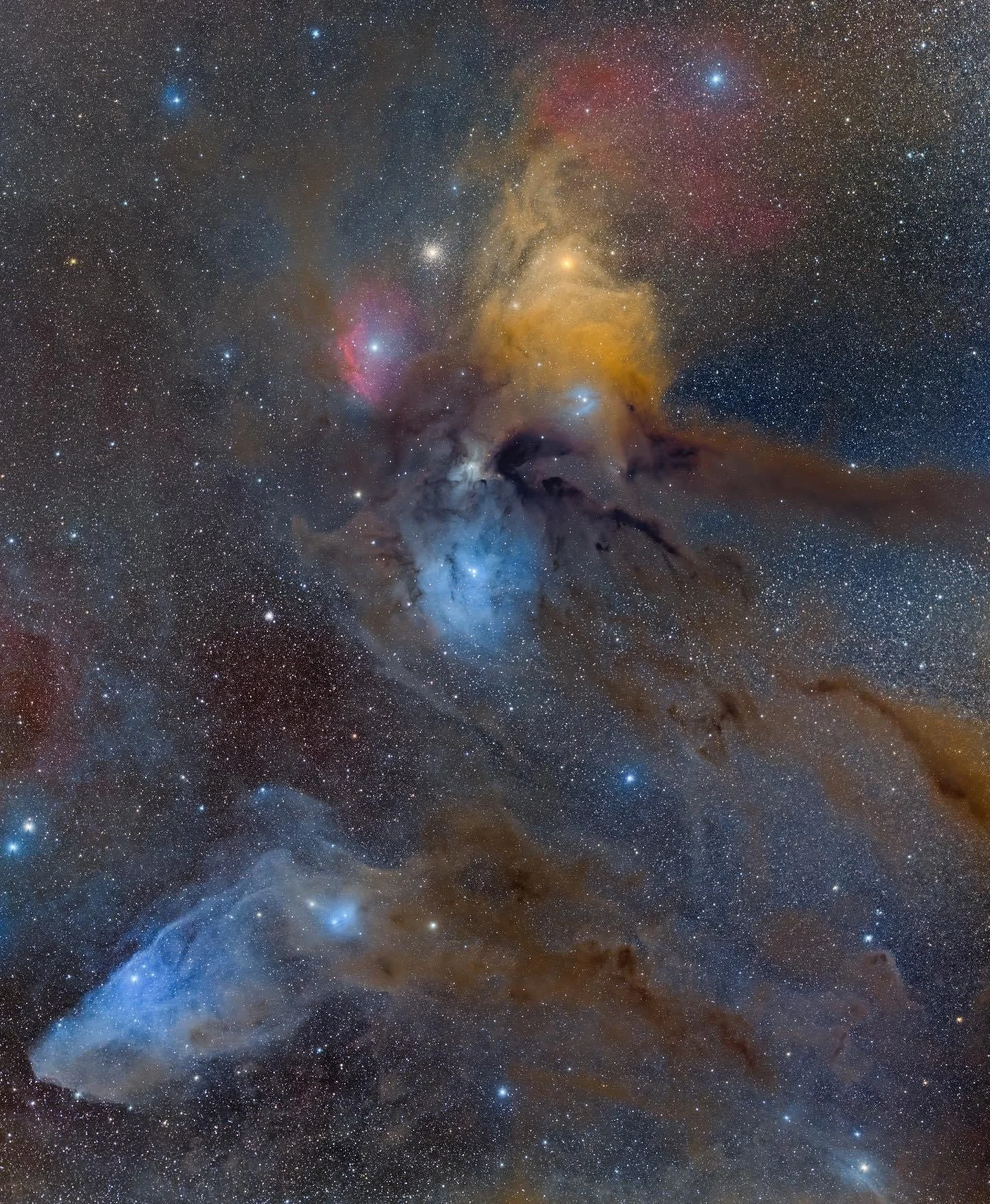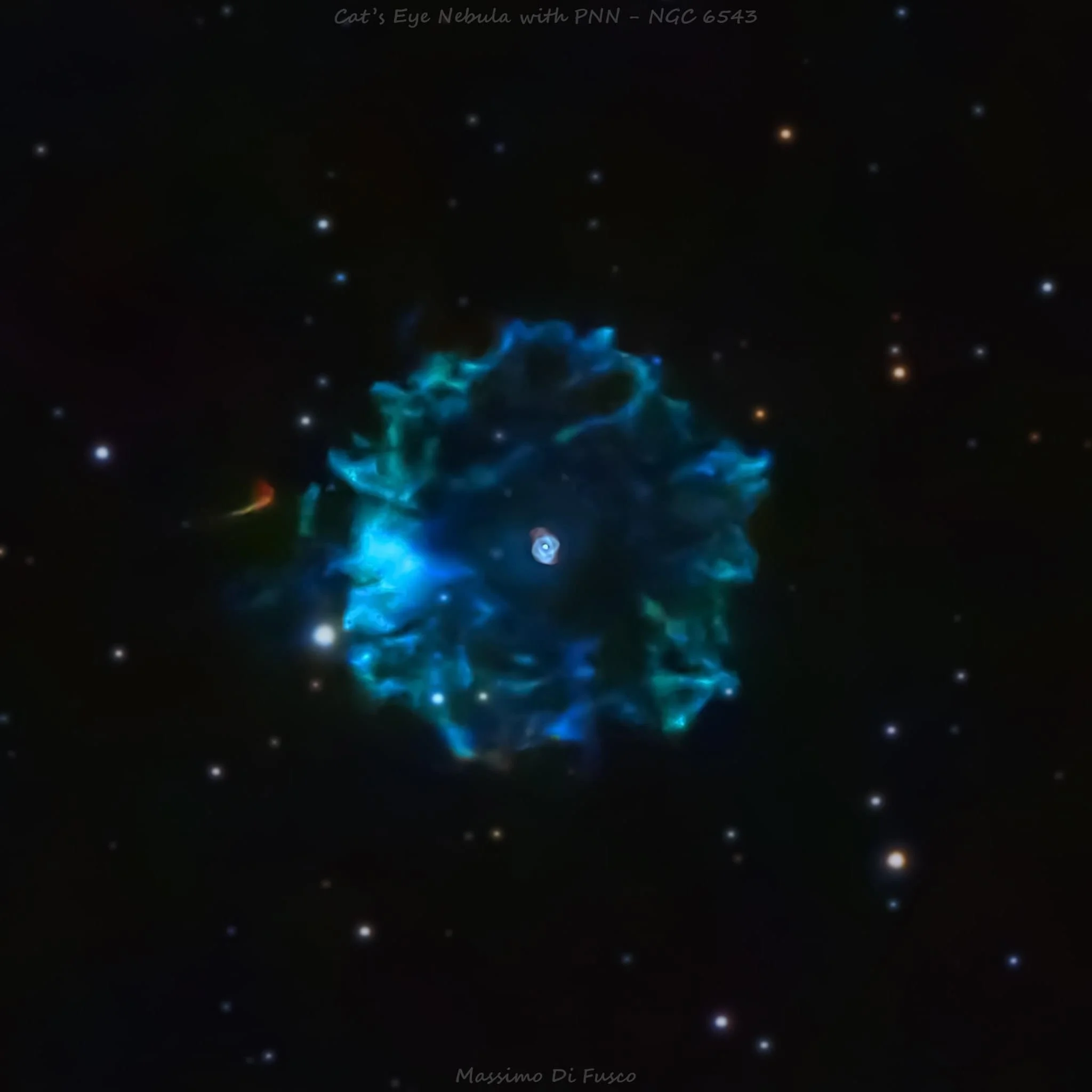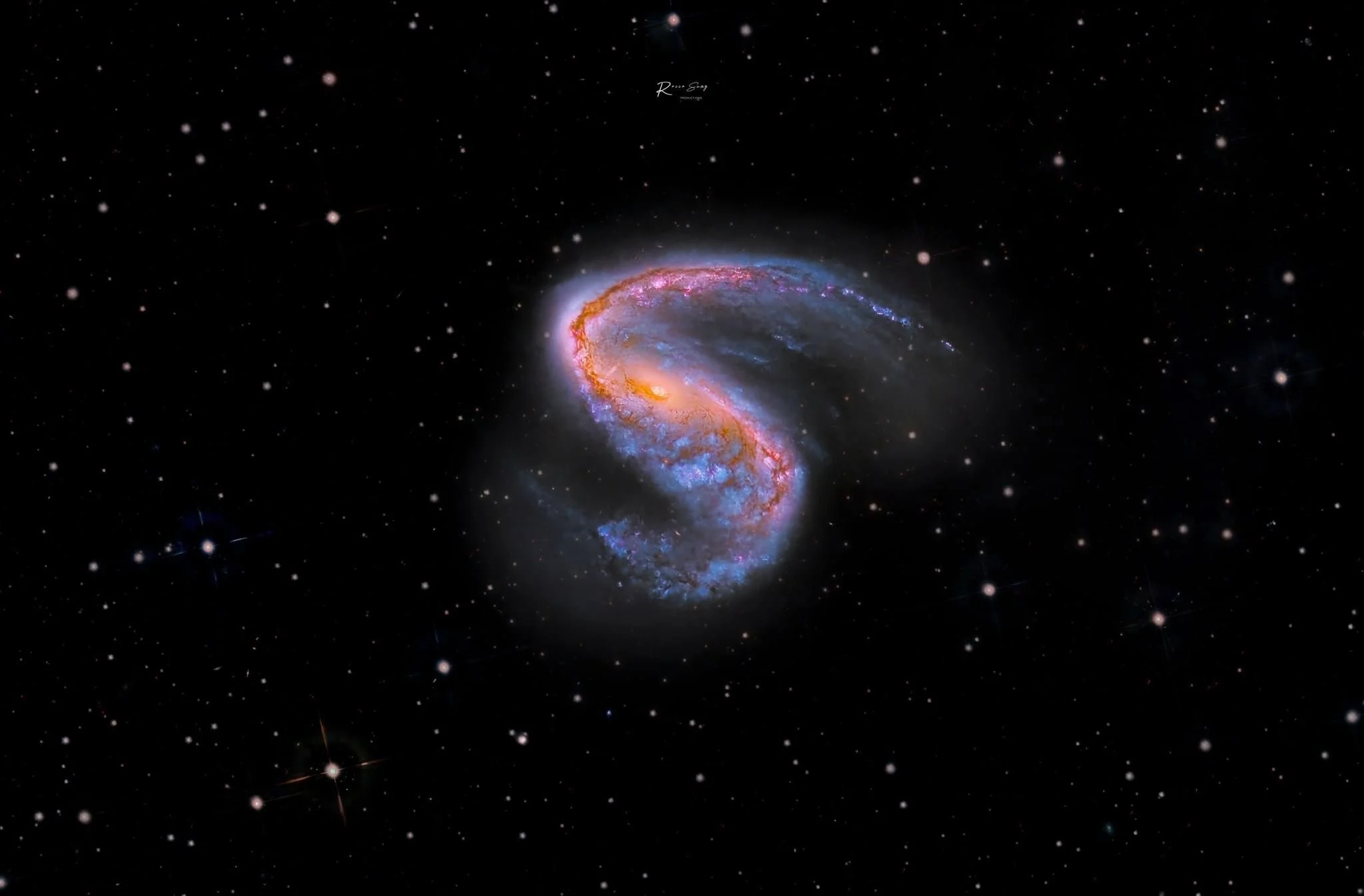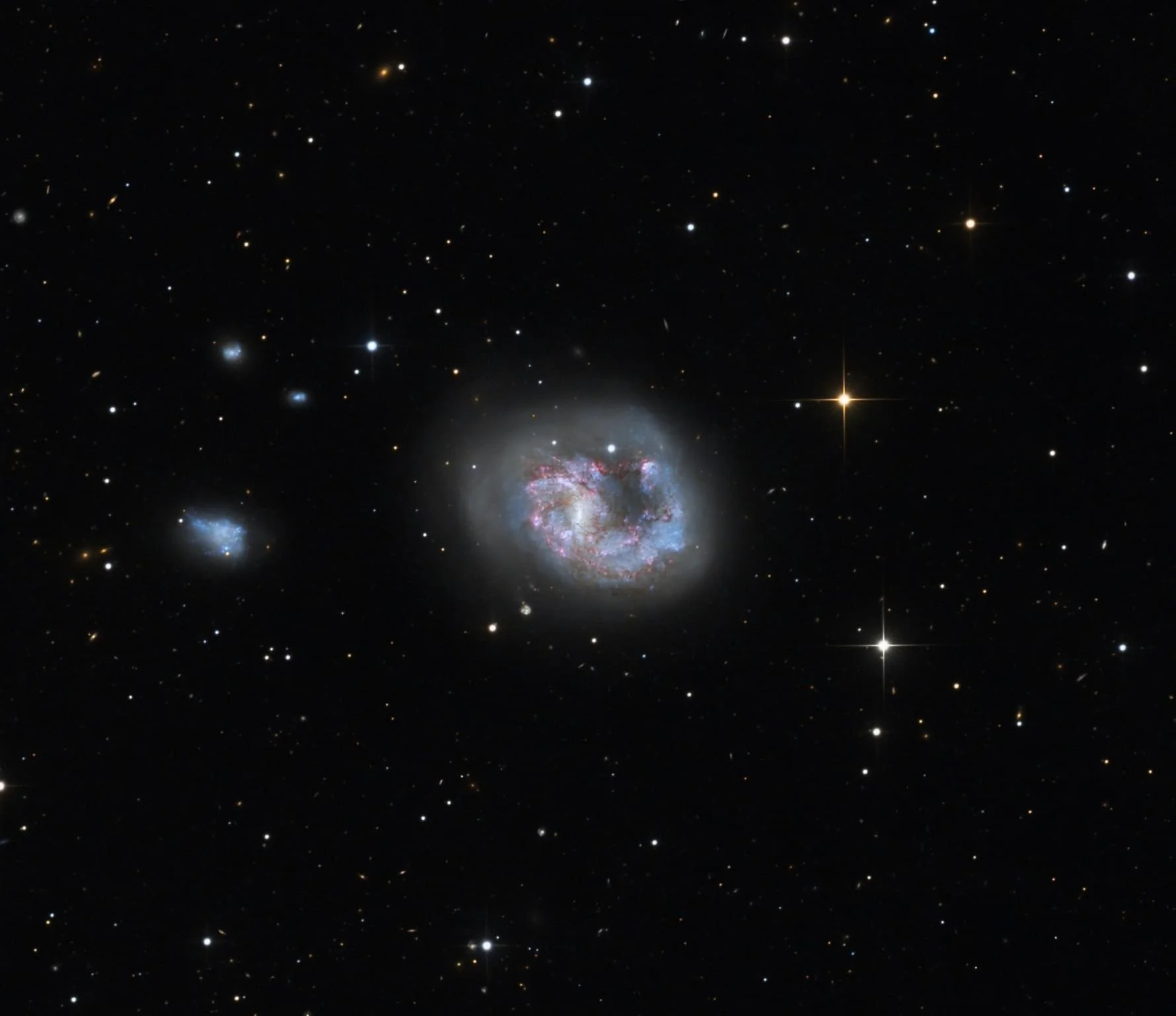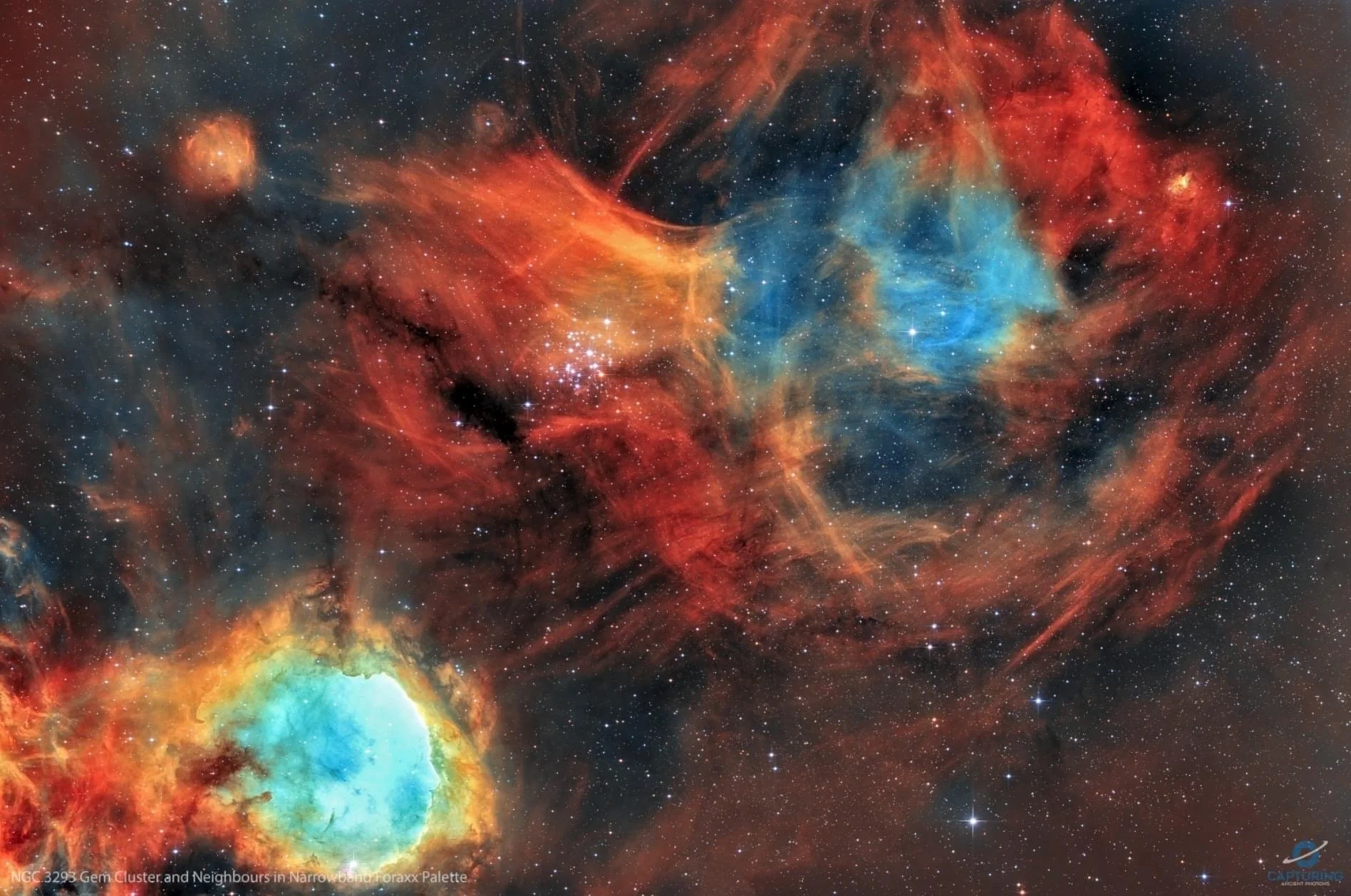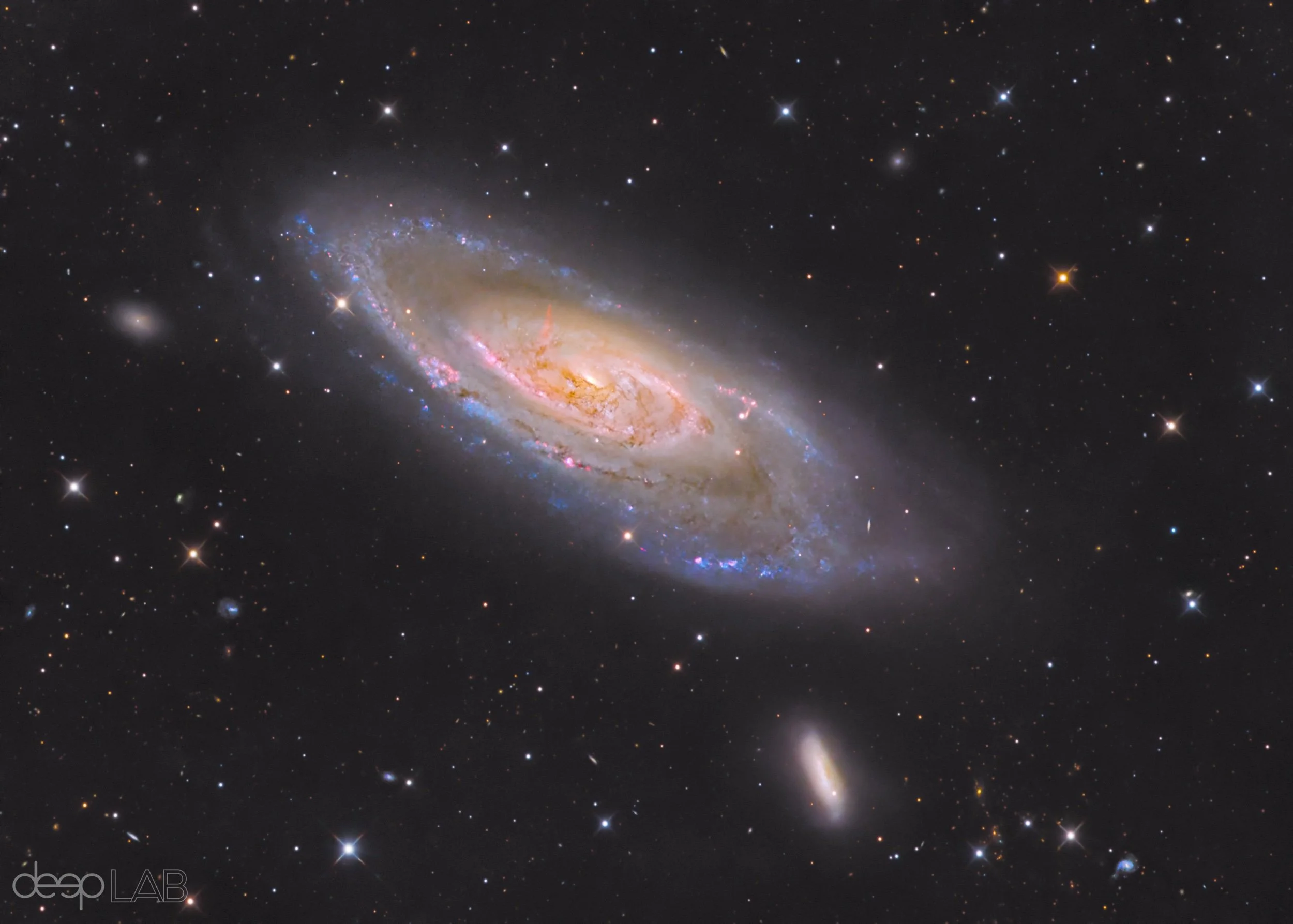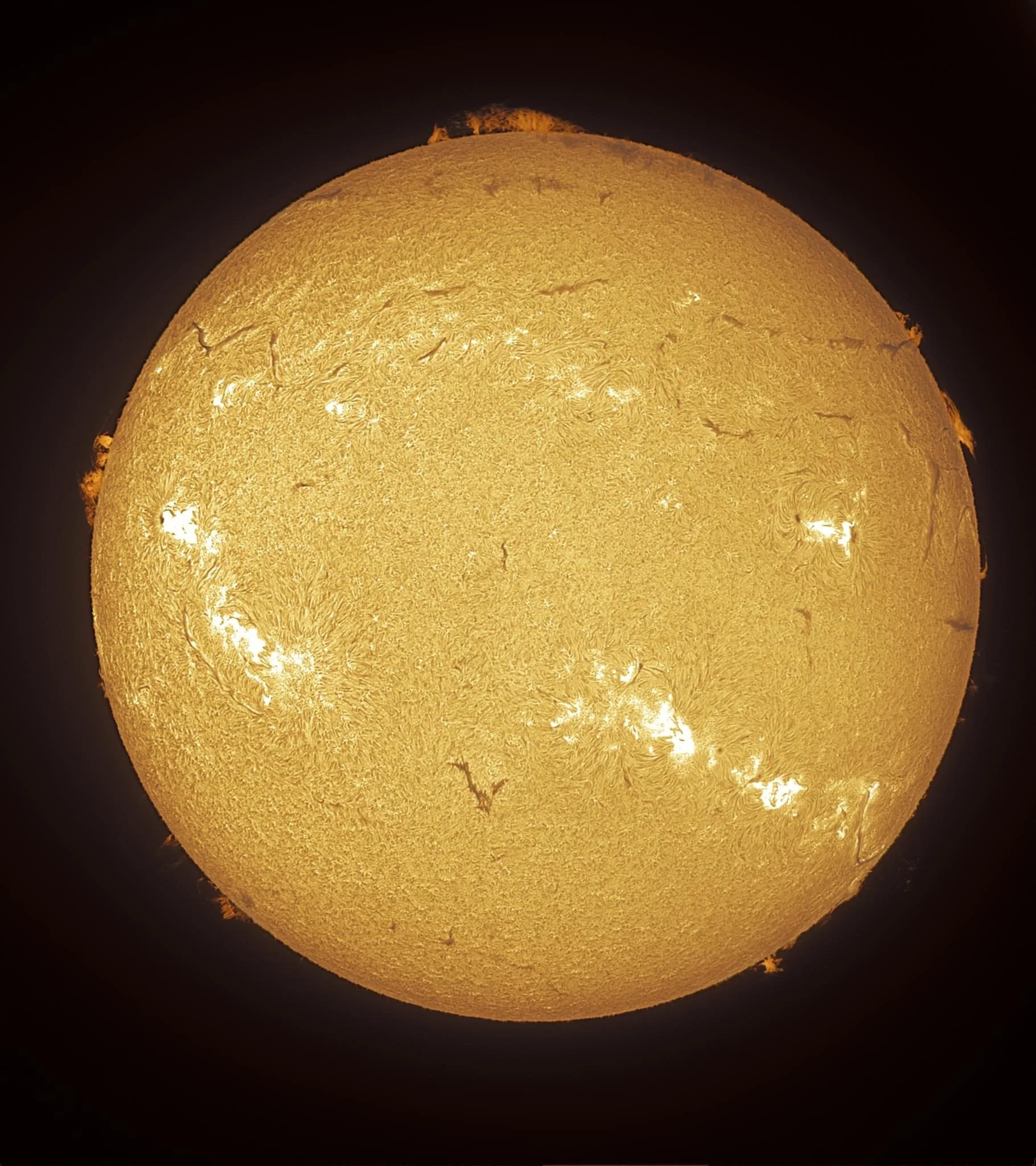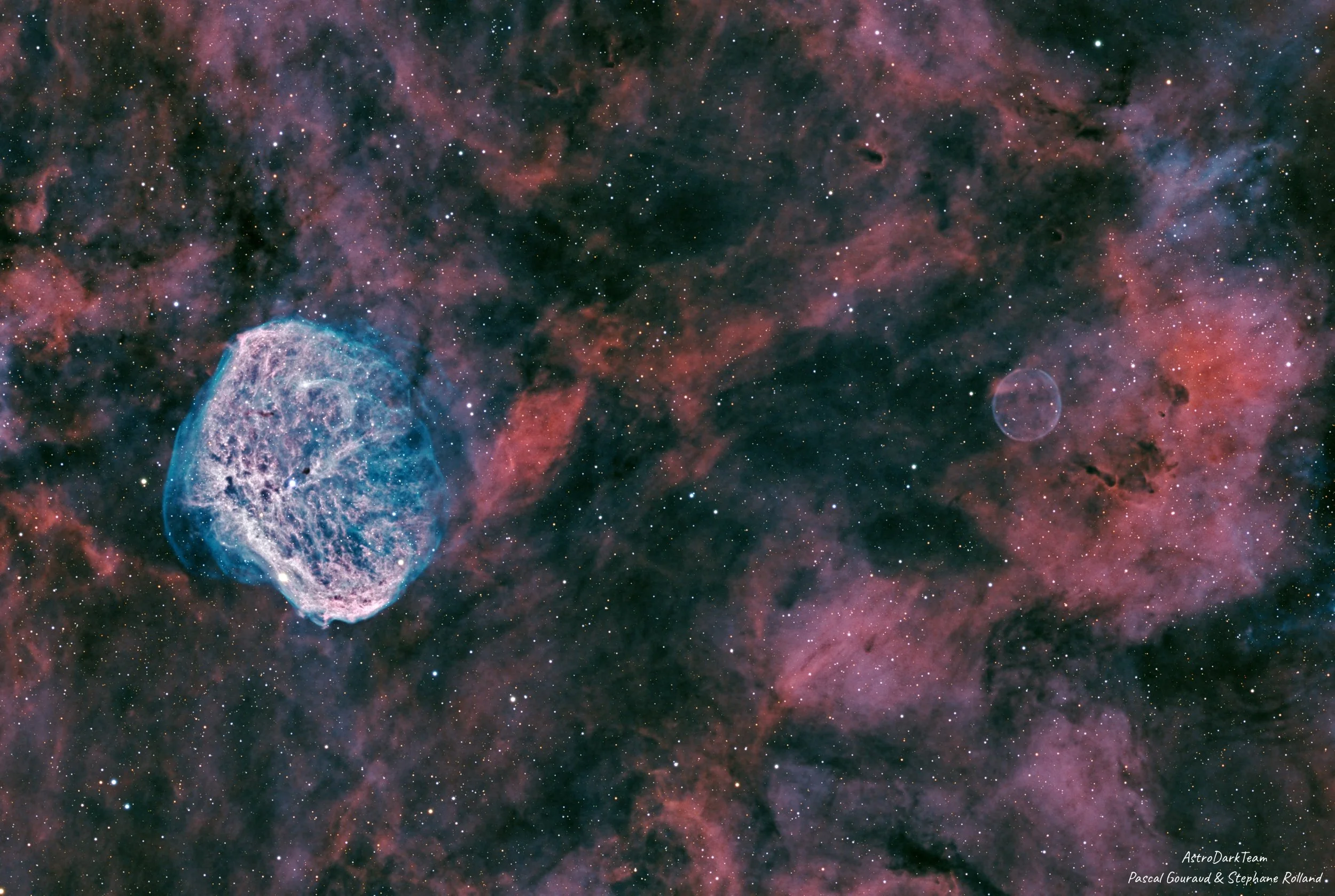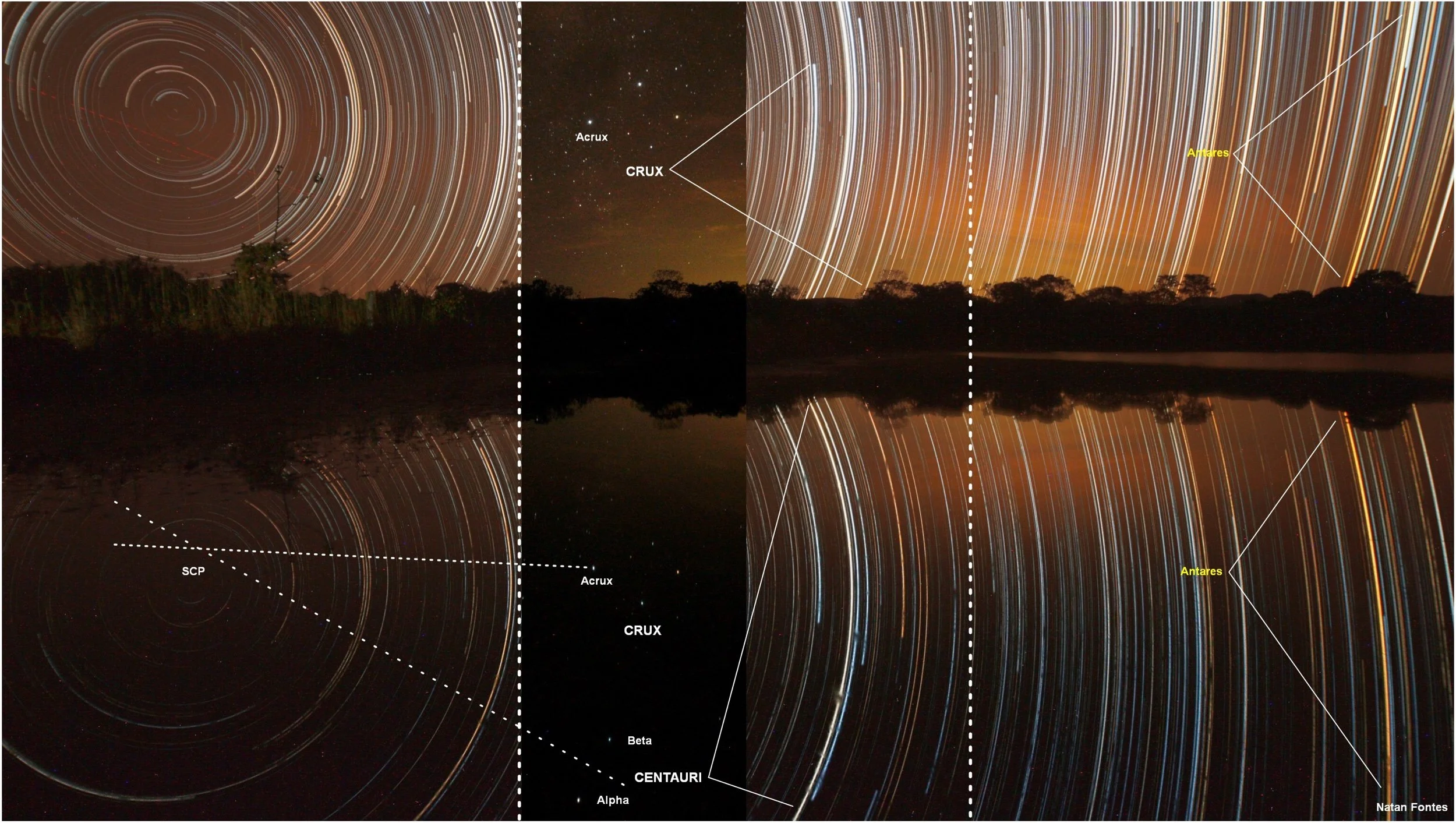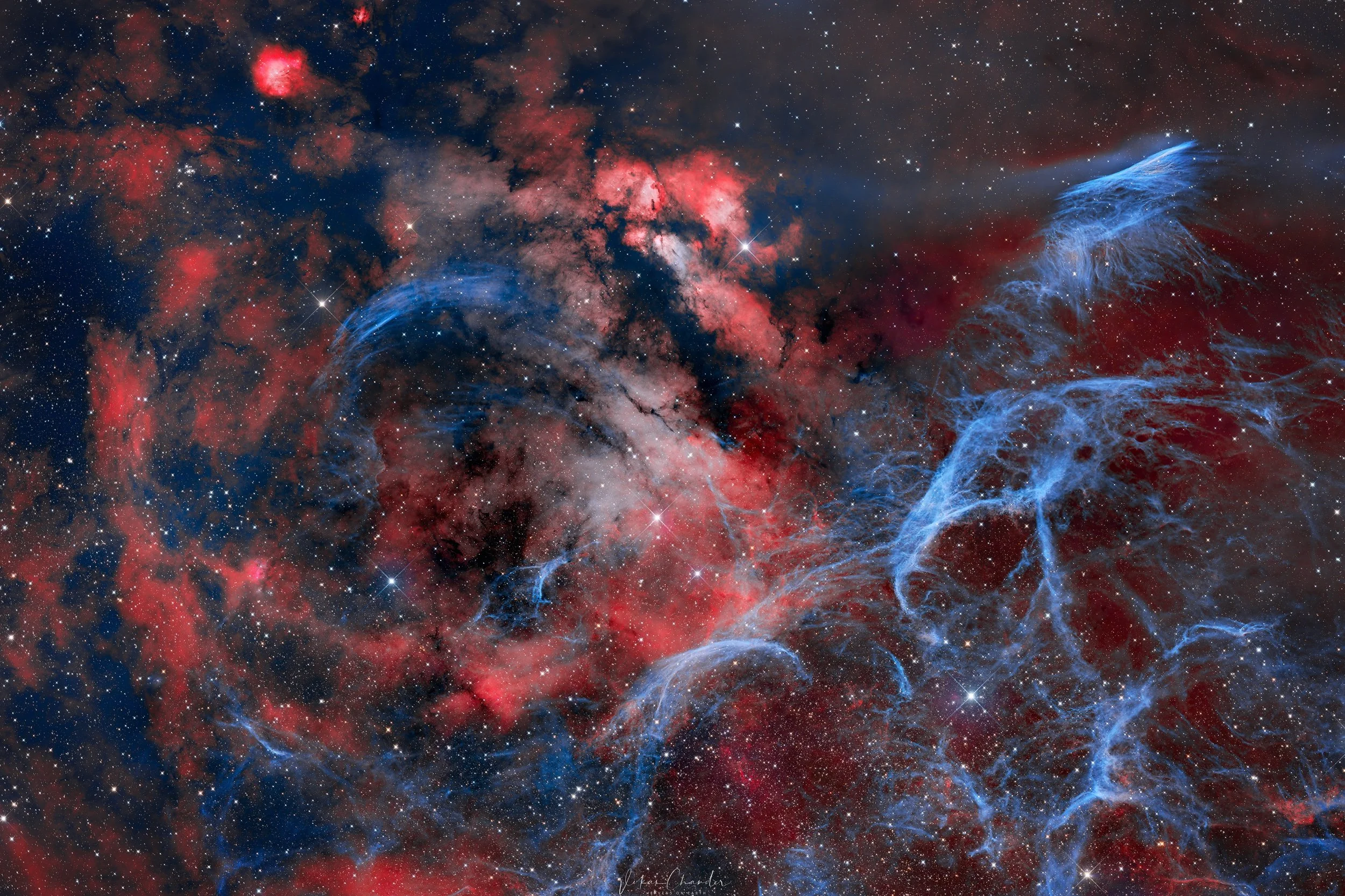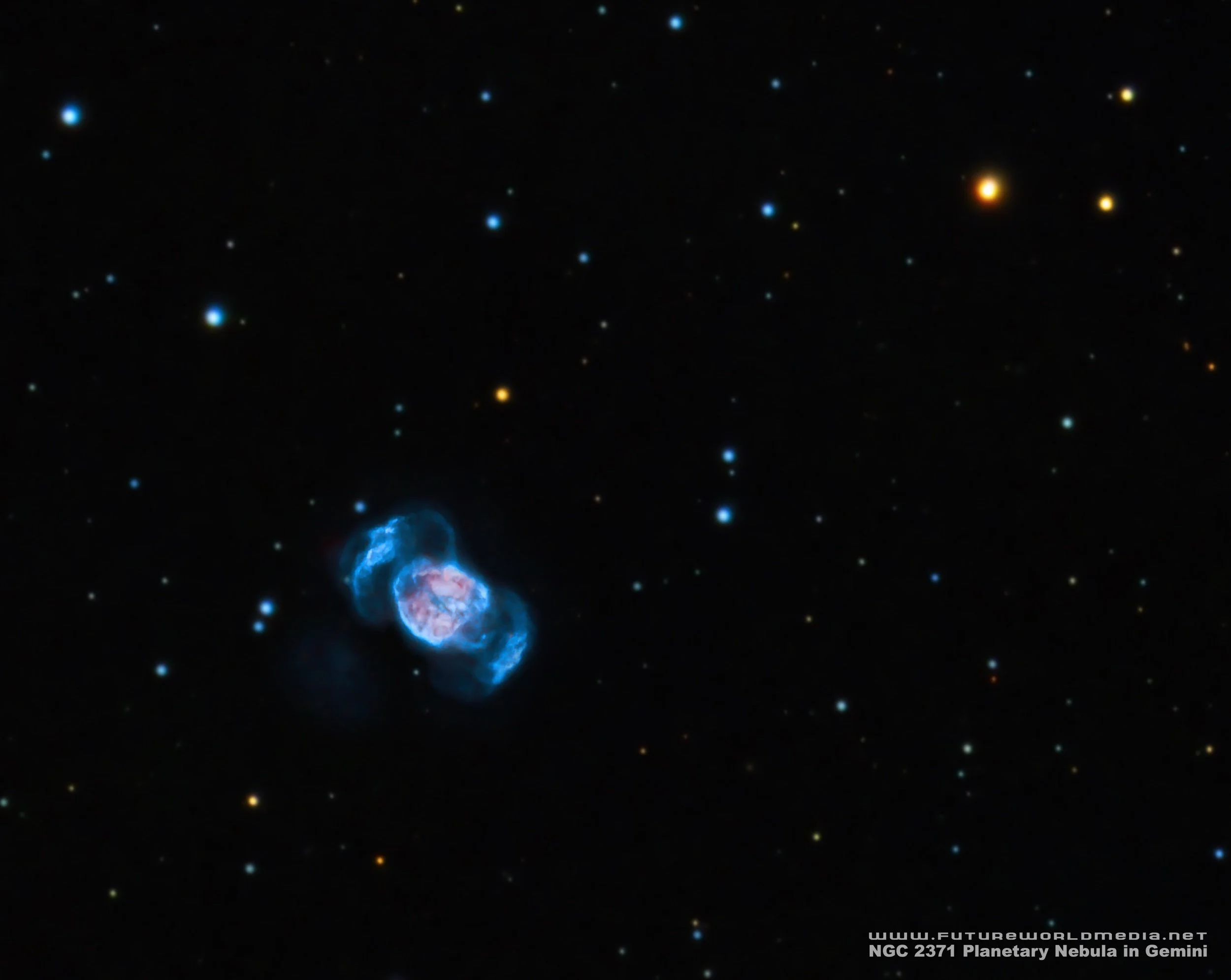
AAPOD2 Image Archives
The Millipede
Image Description and Details : Out of all the possible types of targets one can image in deep space, dark nebulae intrigue me the most. They invoke feelings of mystique and dread, often ominous, and draws the mind’s eye towards what may lie in those dusty depths and beyond. Also known as absorption nebulae, they appear so because of sub-micrometre-sized dust particles, coated with frozen carbon monoxide and nitrogen, which effectively absorb and block the passage of light at visible wavelengths in space. Some parts of these nebulae are so dense that they completely block the light emanating from stars and nebulae behind them, creating what appears to the eye as huge voids of space. Their shapes are very irregular, having no clearly defined outer boundaries and sometimes take on convoluted serpentine shapes, as seen in this image
In the obscure southern constellation of Muska lies a long dust cloud, spanning more than 6 degrees often referred to as the Dark Doodad. A search amongst various dictionaries refer to a Doodad as an ornament or electronic part whose name is forgotten. To my mind’s eye it looks more like a millipede floating in space and I prefer to call it such. Also seen is the bright blue star y Mus and the star cluster NGC 4372.
I imaged this from the dark skies of Chile, with my fast Takahashi E160ed scope, which is located in a remote observatory, DeepSkyChile. This combination is best suited to bring out all the details of dark nebulae. To fit the entire form of this particular dark nebula, which spans over 6 degrees of the night sky I decided to do a 2 panel mosaic. Dark nebulae are notorious to image with any great semblance of detail as they are very faint and to mitigate this, each panel was set up for 25 hours of data acquisition, resulting in a total integration of 50 hours. I have also upgraded my filters to the Astronomik Deep Sky series which controls the halos of the stars very well, blue being particularly notorious in producing large halos around bright stars on fast scopes. Pixinsight offers some great tools for stitching mosaics and I made use of its capabilities to process the image to its current state, applying some final spit and polish in Photoshop.
Telescope: Takahashi E160ed F3.3
Camera: Zwo 6200mmpro
Mount: Software Bisque Paramount MX+
Observatory : Deep Sky Chile
L = 120 x 5 mins per panel
R= 60 x 5mins per panel
G= 60 x 5 mins per panel
B= 60 x 5 mins per panel
Total integration = 50hrs total
Software = Voyager, Pixinsight, photoshop
Copyright: vikas chander
IC 5146 Cocoon Nebula
Newton Orion 254/1000 astrograph
Camera ASI Zwo 294 pro
Skywatcher Eq6 pro mount
79 x 300s gain 220 -10° L-eNhance filter
59 x 300s gain 122 -10° L-pro filter
Software: SGP, Nina, Pixinsight and Photoshop
Copyright: Luca Dinoi
Omega Centauri
Image Description and Details : Taken with my 36.8 cm F9 Ritchey Chretien and STXL6303 CCD camera from my backyard observatory in Canberra Australia. This is a standard LRGB image with luminance = red = green = blue = 50 minutes. Processing in MaximDL, Pixinsight and Adobe photoshop CC
Copyright: Steve Crouch
The Colorful Clouds of Scorpius
Just outside the milkyway core is (in my opinion) the most beautiful area of the sky. These two objects, known as Rho Ophiuchus and the blue horsehead, exhibit most types of nebula in the sky; blue and yellow reflection, red emissions, and dark dusty nebulae.
This is an image I’ve wanted to shoot for many years, but just finally got around to doing it justice in my eyes.
Shot with my travel rig; @rokinon 135mm f/2.8, @zwoasi 2600mc and AM5. 2 panel mosaic, each 20x300” for just over 3 hours of total exposure.
©️ @goodastronomy
Ngc6543
During this time a bit of astrophotography stall, waiting to start photographing the summer nebulaes, I wanted to try out an experiment using the small planetary chamber Asi224 to capture the nucleus of the Cat's Eye nebula (NGC 6543). I basically used the same technique that is used for planetary footage, aka the lucky imaging technique, mounting a Barlow 2x lens to bring the focal point of my telescope to 2000mm.
Convinced myself to try this shot/feat with a simple Newton 200/1000 after meeting someone crazier than me (guess who? ) that taught me to dare to push my own setup to the limit. So, I got the center of NGC 6543 and started for 2 nights in a row (plus a test night) 6/7 hours of video without driving (blessed Eq6r!!! ). From these videos, then, I extracted 50% of the best frames that were aligned and summed up to get the final picture of the kernel which was subsequently mounted along with the Cat's Eye nebula long exposure photo I had taken earlier in the year. Another novelty for me in this experiment was the use of GIMP to join the two photos together
The Cat's Eye Nebula (also known as NGC 6543 or Caldwell 6) is a planetary nebula in the northern Dragon constellation, discovered by William Herschel on February 15, 1786. It was the first planetary nebula whose spectrum was studied by British amateur astronomer William Huggins, proving that planetary nebuluses were gassy in nature and not stellar. Structurally, the object was studied with high-resolution images obtained from the Hubble Space Telescope that reveal nodes, jets, bubbles and complex arcs illuminated from the core of the central heating planetary nebula (PNN).
For the outer nebula:
Konus 200/1000 @960mm, f/4.8
Qhyccd Qhy168c @-20 °C
Sky-Watcher Eq6r Pro mount
Optolong L_Ultimate filter 265x300"
N.I.N.A., APP, PixInsight, PS
To the core:
Konus 200/1000 @2000mm, f/10
ZWO Asi224mc (gain 550) with 2x Barlow lens
Svbony UV/IR-cut filter 1766x1"
Svbony UV/IR-cut filter 11460x0.75"
Svbony UV/IR-cut filter 14025x0.5"
Sharpcap 3.2, pipp, auto beautiful! 3, PixInsight, GIMP, PS
Copyright: Massimo Fusco
Aurora
Image Description: Last night surprised me a million times. What was that even...?
I was sitting quietly outside my house on this ultra warm evening at the telescope when the guiding gave me problems and EAF started driving like possessed... I said a few indecent words, moved from the chair to get rid of "this state" and looked at the sky.
I didn't do it well, because I started rubbing my eyes with surprise, after wk... no trace, just a tide of euphoria, a run for my camera that I haven't yet figured out from the Baltic sand, as well as the tripod
... and a long one into the field bit muddy but it didn't matter.
I even shouted at the Young one to get it together and saw it with his own eyes
Waves spilled across the northern horizon, slightly green, and above my head I looked every moment at a growing pillar, entering the zenith.
51°... N, 21°... E
How is this even possible..?! I was not interested in it at all.
Thought I would give a call to those who would like to see it in person.
I stood in this mud, between the green grain and the greenish sky, I called, I caught my breath, I called again, I turned the blinker on between ... and I absorbed all of myself.
The dawn has taken many forms... From the poles, to the waves, to the bubbles, the souls that came and went - from the west side of the sky, to the north, to the east... Unbelievable.
I couldn't sleep in a very long time.. until three with minutes I trampled the path around the house...
I took some pictures, although they didn't need much, I assembled panoramas of which the shorter one is ok (5 horizontal frames), but the longer one (10 vertical frames) strongly bent by PS, plus stratrails with a free bolid (? ), plus a couple of individual frames.
Technically: Canon 7Dmk2 + Canon 10-22 mm, on a tripod, in the north of Puława and Nitrogen Plants, in the northwest Electronics Kozienice.
Copyright: Kamila Mazurkiewicz Osiak
M 63 Sunflower Galaxy
Image Description: M63 lies at a distance of 27 million light years from our own Galaxy in the constellation of Canes Venatici. Its size is approximately 99,000 x 57, 000 light years.
To the lower left of the Galaxy there are horizontal dust lanes presumed to be not part of the disk, but lay in front of the Galaxy.
The spiral pattern is mostly fragmented indicating possible supernovas exploding in star formation regions.
Imaged over 5 nights using various combinations of angular rotation and guiding. The next time I image this Galaxy I will use a much longer focal length as this image is a tight crop of the original field of view.
Technical summary:
Captured: 14,15,19,20,21-03-2023
Imaging Sessions: 5
Location: Gérgal, Andalucía, Spain
Bortle Class: 4
Total Integration: 24h 55m
Filters:
Red 42x 300s 3h 00m BIN 2 Gain 100 -5C SQM 20.6
Green 43x 300s 3h 35m BIN 2 Gain 100 -5C SQM 20.5
Blue 43x 300s 3h 35m BIN 2 Gain 100 -5C SQM 20.6
UV/IR 171x 300s 14h 15m BIN 2 Gain 100 -5C SQM 20.6
Pixel Scale: 0.8 arcsec/pixel
Telescope: Celestron C11 Edge HD x0.7 f/7 @ 1960mm fl
Image Camera: ZWO ASI 6200MM Pro
Guiding: ZWO OAG L with ZWO ASI 192MM Mini
Filters: Astronomik R, G, B, UV/IR
Mount: Skywatcher EQ6-R Pro
Computer: Minix NUC
Capture software: NINA, PHD2
Processing Software: PixInsight, Adobe Lightroom
Copyright: Eric Smith
Crater Lake
"Crater Lake"
Crater Lake National Park has been on my wish list for a big Milky Way panorama ever since my first visit several years ago.
5 years and several attempts later, I finally found perfect conditions during my visit in late June 2022. I was surprised that a thick snow cover was still present. It kept me from reaching my planned shooting location, but it nicely framed the crater rim at my alternate spot.
EXIF
Canon EOS R, astro-modified
Tamron 15-30mm f/2.8 @ 15mm
IDAS NBZ-Filter
iOptron SkyTracker Pro
Sky:
Panorama of 7 panels, each a stack of 6x 90s @ ISO1600, unfiltered & 3x 180s @ ISO6400, filtered
Foreground:
Panorama of 7 panels, each 15s @ ISO400 during twilight
Copyright: Ralf Rohner
NGC 3293
NGC 3293 is an Open Cluster consisting of more than 100 stars brighter than magnitude 14 and within some impressive surrounding Ha nebulosity. This cluster which is around 9,00 light-years from Earth is located in the constellation Carina and shares the cosmic neighborhood with the popular NGC 3324 Gabriela Mistral.
94 x 300s SHO and 116 x 30s RGB subs shot @0C across 5 nights for a total integration time of about 9hrs
Equipment used:
Skywatcher 10" f4 Newtonian 250P
Skywatcher F4 Aplanatic Coma Corrector
Skywatcher NEQ6 Pro Hypertuned by Astronomy Academy Perth
ZWO ASI2600MM Pro Cooled Camera
Primaluce Sesto Senso2 Electronic Focuser
William Optics Uniguide 50/200mm guidescope
ZWO ASI290MM Mini Guide Camera
ZWO Electronic Filter Wheel
Antlia Pro 36mm unmounted filters
Rollon rolloff modified shed observatory
Bortle 5
Data acquisition software: NINA Astronomy Software
Processing software: PixInsight and Photoshop CC
Sh2-284 - The Finger
Image Description and Details : Sh2-284 is a very large emission nebula about 17,000 light years from us in an outer arm of our galaxy. As with a number of emission nebulas like it, its central region contains an open cluster of massive, young, hot stars whose stellar winds are clearing out the center and creating a bubble or cave-like structure while creating pillars and cometary globules at the edges. Once such pillar in Sh2-284 (on the right) looks like an index finger pointing at the center of the nebula in a "We're Number 1" sort of way.
Details: Celestron EdgeHD 1100 with 0.7x reducer; 10Micron GM1000; ZWO ASI6200MM; Chroma broadband filters for the stars and 3nm narrowband filters for the nebula; Bortle 8; 19h 13' integration time.
Copyright: Timothy Martin
M106 - The cosmic funnel
Image Description and Details : The last work of LAB1 observatory of our DeepLab project, processed by Massimiliano Peri.
The M106 requires 2 month to reach the result: rain, wind and moon were out enemy!
Instrumentation:
SCOPE: Tecnosky RC12 Carbon Truss
CAMERA: ZWO ASI2600MM Pro
MOUNT: iOptron CEM120
Acquisition details:
Optolong Blue 2": 45×180″(2h 15′)
Optolong Green 2": 46×180″(2h 18′)
Optolong H-Alpha 7nm 2": 39×600″(6h 30′)
Optolong Luminance 2": 90×300″(7h 30′)
Optolong Red 2": 47×180″(2h 21′)
Copyright: DeepLab Project
April Sun
Sun disc on April 15th, 2023.
How frustrating when the clouds followed the sun for an hour after everything is set up and ready to go....
With so many previous practices, I think I have figured out a way to produce high-resolution Solar disc images. Originally I have to produce a higher-resolution image using 2 panels mosaic with 2X Barlow. However realizing that the magnification of a Barlow actually depends on the distance from the Barlow lens to the camera sensor, I decided to put the Barlow lens closer to the sensor by screwing it directly onto the camera. The solar disc is not fitting perfectly in a single frame of my Apollo M-Max. My next project idea will be using this configuration to make a good quality timelapse.
Scope: Lunt60DS50, B1200
Mount: Sky-Watcher Solar Quest
Camera: Apollo M-Max
Barlow: Celestron Omni 2X
Shutter: 7ms, gain:219, Exposure: 90s; 135fps
Drizzle 3X
https://www.astrobin.com/qcmwz7/
FireCapture, Imppg, Photoshop
Copyright: Benjamins Astrophotography Hub
Ngc6888
Image Description and Details : Our 7th deep sky target, imaged from the remote observatory in Portugal by the AstroDarkTeam composed of Pascal Gouraud and Stéphane Rolland.
We have been installed 18 month ago and already more than 550 hours of imaging!
Thanks again to the French Astro ARO team for the efficient and effective management of this superb site that hosts us.
We propose this time the Crescent Nebula (on the left) and the Soap Bubble Nebula (on the right),these two beauties of the sky evolve within an ample clouds of gas and dust drift through rich star fields along the plane of our Milky Way Galaxy toward the Cygnus constellation.
Technical Details :
239 images for a total of 30 h have been integrated between the September 22th 2022 and the November 05th 2022. To build this HOO image, we used 9.5 h for HA, 12.75 h for OIII, 2.75 h for R, 2 h for G, 2.75 h for B from a TOA telescope 130mm in diameter, 1000mm focal length, Moonlite Nightcrawler 35 focuser/rotator,
ASI2600MM monochrome camera cooled to -10 degrees, ZWO filter wheel with 36mm Chroma SHO 3nm and LRGB filters.
Autoguiding optical splitter ZWO with Camera ASI290MM, EQ8-R Mount Software MaxPilote, The Sky X Pro, Focus Max V3.
PixInsight processing.
Copyright: Copyright: AstroDarkTeam
Mirrored star trail
Image Description and Details : The constellation Crux, very present in the sky of the Southern Hemisphere, is the smallest of the 88 constellations (IAU), it served as an important point of reference for the location of the South direction, in the period of the great navigations, from the 15th century onwards.
The pole rotation records show the beautiful star trails, but hide the wonderful constellations, stars and planets that appear as curved lines. In this photo, the brightest star trails predominantly around the South Celestial Pole (SCP) appear, but also the beautiful constellations and stars that would otherwise be hidden. In the center, a part of one of the original photos was inserted to highlight the constellations Crux and Centaurus (Alpha and Beta) present during the capture, showing their star trails, both the upper part (of the sky) and the lower part ( of the lake), mirrored in a beautiful and serene lake.
On the right side of the photo, the star Antares, records a beautiful yellowish star trail.
At the bottom of the original photo (center) are the Crux and Centaurus constellation mirrored in the lake, with dashed lines (left), pointing to the region near the South Celestial Pole in mirrored form, recording a basic technique to find the region near the SCP.
The 1,136 photos that make up this record (over six and a half hours of capture) were taken in the Midwest of Brazil, during the 13th Brazilian Astrophotography Meeting (13th EBA – Encontro Brasileiro de Astrofotografia), in July 2022.
Equipment: Canon EOS REBEL T4i camera, with power bank, Bower 14mm ED AS IF UMC 2.8 lens, battery-powered lens heater and Manfrotto Fixed Tripod. Programs: Startrails, IrfanView 64 and Affinity Photo.
Copyright: Natan Fontes
Vela Widefield
Image Description and Details : Vela Widefield!
Call me a widefield junkie if you will…. the wider the better !! And if it is in the Southern Hemisphere, then that’s the icing on the cake. This 2 panel mosaic spans about 6 degrees across a widefield region in the constellation of Vela. The blue gas clouds are from the remnants of the Vela Supernova and one can see NGC 2736, or the Pencil Nebula glow brightly on the right of the frame. The nebula's shape suggests that it is part of a supernova shock wave that has encountered a region of dense gas. It is this interaction that causes the nebula to glow and form ripples. RCW 38 dominates the center of the frame and is an HII region with dark clouds enshrouding recently formed stars. The gases and clouds come together to form a rich tapestry of glowing reds and dark blacks. Also seen in the image are RCW 39 and 40 amongst lots of other fine details…..
Telescope: Takahashi E160ed
Camera: Zwo 6200mm pro
Mount: Software Bisque Paramount MX+
Observatory : Deep Sky Chile
2 Panel Mosaic
L = 300s x 36
R= 300s x 24
G= 300s x 24
B= 300s x 24
Ha = 300s x 24
Oiii = 600s x 24
Total integration = 15hrs per panel, 30hrs total
Software = NINA, Pixinsight
Copyright: vikas chander
Towards Orion
"Towards Orion"
Befor you draw your conclusions, let me explain this image: The sky and foreground were captured back to back at the same focal length and with the same equipment from a single tripod position.
The camera position was roughly 2 miles away from the mountain station, and the telescope/camera combination has an extremely narrow field of view of only 1.5° x 2°. The resulting telephoto compression makes the otherwise tiny Orion Nebula appear huge.
Two years ago, I had already captured a similar deepscape, but I was never really satisfied with it. The problem was lacking data for my sky, especially in the green channel, as clouds moved in towards the end of the imaging session.
Of course, I could have recaptured the missing data or the entire Orion Nebula from a different place, but that's not my style. After waiting two years for an opportunity to reshoot the image, I finally got my chance this February.
The weather this time was perfect, which made capturing the sky pretty straightforward, but otherwise, the conditions were still as demanding as 2 years ago.
Getting the foreground in focus with a monochrome micro 4/3rd astro-cam and RGB filters through a 500mm f/5.6 telescope is a real pain. Furthermore, snowcats grooming the slopes caused constantly changing, extremely bright illumination. Considering this, I am quite happy that I was able to capture a usable foreground.
EXIF
Cameta: ZWO ASI 1600MM Pro (cooled monochrome MFT astro-cam)
Telescope: William Optics Megrez 88 (500mm f/5.6)
Filters: Baader HaRGB
Other equipment: ZWO EFW and EAF
Autoguider: ZWO ASI 385MC
Mount: Equatoriallly mounted Skywatcher AZ-GTI
Rig control: ASIair
Sky:
25min RGB (each) (30s, 10s & 3s subs)
21min Ha (7 x 180s)
Foreground:
5x 60s RGB (each)
10 x 60s Luminance
Copyright: Ralph Rohner
NGC 2371 Planetary Nebula
Image Description and Details : I first attempted this tiny planetary nebula back in 2019.
I decided to attempt it again by piling on more data, adding in RGB for star color and even tried drizzling the data at 3x instead of 2x. I am much happier with the results. It still took a lot of massaging of the data to get it where I wanted it to be, however.
NGC 2371 is a planetary nebula, the glowing remains of a Sun-like star. The remnant star visible at the centre of NGC 2371 is the super-hot core of the former red giant, now stripped of its outer layers. Its surface temperature is a scorching 240,000 degrees Fahrenheit. NGC 2371 lies about 4,300 light-years away in the constellation Gemini. It is one of the largest planetary nebulas known, measuring roughly three light-years across.
It confused astronomers when it was first studied. Rather than being classified as a single object, it was instead recorded as two objects, named NGC 2371 and NGC 2372, owing to its symmetrical lobed structure.
It is filled with dense knots of gas, fast-moving jets that appear to be changing direction over time, and expanding clouds of material streaming outwards on diametrically opposite sides of the remnant star.
Copyright: Douglas J Struble

